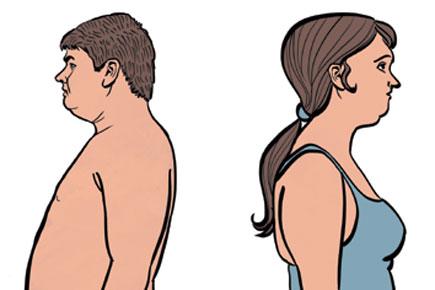The 40s are a crucial time for men and women. By this age, most would have reached a stage where they can afford to slow down, and enjoy life more. But, like the mind, bodily functions also begin to slow down, affecting joints, skin, vision and other vital organs like the heart

In the first of a three-part series, Hassan M Kamal has created a manual on possible ailments to watch out for as one reaches the 40s.
Weight gain
Your metabolism starts slowing down once you reach your 40s.
ADVERTISEMENT
It’s advisable to cut your calorie intake, and start doing some form of aerobic exercise like running, walking or cycling.

Illustration/ Amit Bandre
Shoulder
Pain in shoulder, discomfort while movement or weakness in strength could be caused by rotator cuff tear (most common), impingement syndrome and tendinitis among others.
Elbow
Bursitis (swelling around your elbow joint) and tendinitis.
Try strength training to improve your bones
“As we age, the tissues in our body become less elastic. This includes those that support ligaments, cartilage etc, and is usually referred to as Arthritis.
When your joints become prone to trauma, the body communicates this to us such that we automatically shift gears,” says Dr Dr Amrapali Patil weight management expert and founder of Trim n Tone. “So, if you have been cycling, you should change to less impact exercises like walking, yoga or pilates.”
Suggestions:
>> Opt for strength training exercises. Include resistance training. This improves bone density, joint elasticity and joint flexibility. Pay attention to the caloric requirements. The diet must be a balanced one.
>> Always check with a genuine expert. Keep at bay what is meant to be kept so. Check with your physician.
Knee and joints
Pain while climbing or going down stairs could be because of a number of reasons including tendinitis, bursitis or patellofemoral pain syndrome among others.
Suggestions:
>> Do regular shoulder exercises to maintain strength and flexibility (like push-ups and pull-ups).
>> SThere’s no set restriction on what you can do and what can’t, but whatever you start with go slow on that. Start with running, jogging or cycling.
Bone mineral density
Men and women suffer from depleting bone mineral density (BDM) as they age. Though, it’s slow, and may not cause osteoporosis all of a sudden, unless you have been suffering from low BDM for a long time, it could affect your daily activities. Among men, it’s linked to testosterone deficiency, whereas in women, depleting oestrogen levels (during perimenopause as well as post-menopause) have been linked to lowering BDM, thus making you more susceptible to fractures.
Suggestions
>> Get bone density checked at least twice a year.
>> In some cases, hormone therapy is also suggested.
Sudden weight or appetite change
“Sudden weight loss or loss of appetite is not a good sign,” adding, “It Could be a cancer anywhere in the body. An unexpected weight gain could also be because of hypothyroidism, large ovarian tumour or fibroid, a benign tumour that originates from the smooth muscle layer myometrium of the uterus.”
Suggestions
>> If it’s a tumour, it has to be removed surgically, but hypothyroidisim can be controlled using hormone therapy or through regular exercise and change in lifestyle.
>> Our metabolism slows down in our 40s, and so a diet change can be useful. Control diet by at least 200 calories.
Try strength training to improve your bones
“As we age, the tissues in our body become less elastic. This includes those that support ligaments, cartilage etc, and is usually referred to as Arthritis. When your joints become prone to trauma, the body communicates this to us such that we automatically shift gears,” says Dr Dr Amrapali Patil (in pic) weight management expert and founder of Trim n Tone. “So, if you have been cycling, you should change to less impact exercises like walking, yoga or pilates.”
Suggestions:
>> Opt for strength training exercises. Include resistance training. This improves bone density, joint elasticity and joint flexibility. Pay attention to the caloric requirements. The diet must be a balanced one.
>> Always check with a genuine expert. Keep at bay what is meant to be kept so. Check with your physician.
The 40s is when women enter perimenopause, a period where the body is trying to make a transition to menopause. This period of transition is like puberty, and can create lots of problems (known as well as new),” writes Dr Rishma Dhillon Pai in her book, Fit at 40. She adds that these changes are physical, psychological as well as cognitive changes.
Dr Nikhil Iyer , arthroscopic consultant and surgeon, Orthocare Clinic, Chembur sees most problems in two types of people in their 40s. “The first group is one who have overdone physical activities while young, and the second who did no physical work while young. And, since Arthritis start hitting in the 40s, it’s important to take special care of bones and muscles,” he says.
Read more on being healthy in your 40s

For men: Your Body at 40+ by Jeff Csatari Available at Amazon.in Price Rs 1,376
For women: Fit at 40+ by Dr Rashmi Dhillon Pai, Random House, Available at Amazon.in Price Rs 209
 Subscribe today by clicking the link and stay updated with the latest news!" Click here!
Subscribe today by clicking the link and stay updated with the latest news!" Click here!







